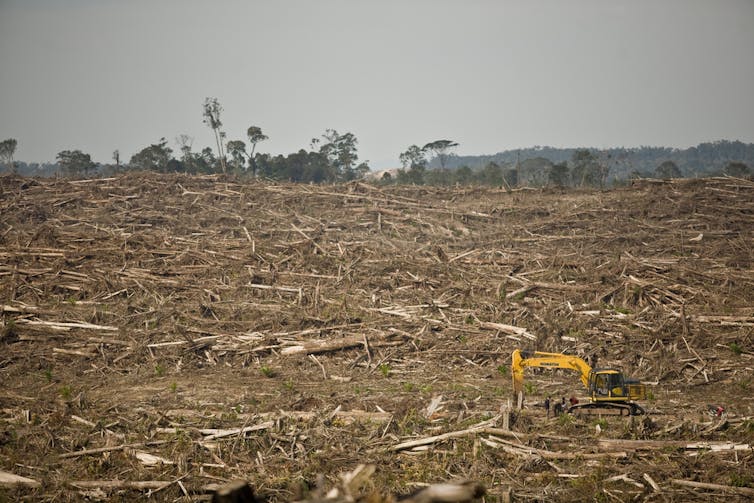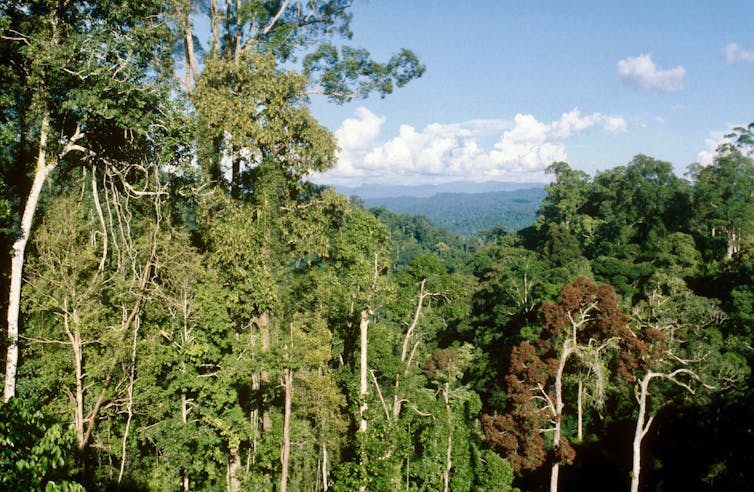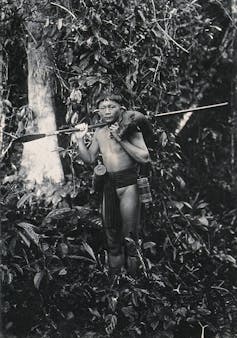Borneo – fourth-largest island in the world, home to more than 20 million people – has always aroused the fascination of explorers. The island is dense with forests, waterways and soaring mountains, and its indigenous population have a deep relationship with the forest.
A fragile landscape
The 743,330km2 island is home to the largest area of forest in Asia. But Borneo is one of the world’s most intensively deforested regions. At the beginning of the 1970s, its forest area was around 56 million hectares. In 45 years 20 million of that has been cut down. Intensive logging, open-pit mining, rapid expansion of agro-industrial plantations – oil palms in particular – and hazardous peatland development all endanger Borneo’s forests.
The migration of the rural poor from the overpopulated islands of Madura, Java and Bali is constitute another threat over the forest. Used to a land-intensive style of farming, they clear the forest to grow crops. At times they come into conflict with the native populations, which can turn violent.
Large wildfires, sparked by droughts caused by the El Niño phenomenon, further destroy the forest.

Orangutan, clouded leopard and … the bearded pig
Borneo is rich in its biodiversity and home to many unique species. Its unique plants include carnivorous nepenthes as well as Rafflesia arnoldii, which produces the largest flower in the world with the smell of rotting flesh. Animals such as the orangutan, Borneo pygmy elephant, clouded leopard, long-nosed monkey and tufted ground squirrel call it home.
One species that is rarely mentioned is the bearded pig, Sus barbatus, despite it being the most emblematic animal of the island. This wild boar owes its name to an abundant tuft of upward- and forward-pointing bristles covering its cheeks and lower jaw. There are two subspecies: S. barbatus oi, present only in Sumatra, and S. barbatus barbatus, present on the Malay Peninsula and Borneo.
The bearded pig is a tireless migrator, either alone or in large herds. It often travels hundreds of kilometres to obtain its preferred foods. In doing so, it plays a crucial role as the gardener of the forests of Borneo.
Tireless gardener of Dipterocarpaceae
To understand this function of the wild boar, it is necessary to evoke the singular feature of Borneo’s forest: the predominance of a family of trees, the Dipterocarpaceae. These tall evergreens, mainly located in low-altitude forests, are easily recognisable by their “crown shyness” – the crowns of mature trees do not touch each other.
Most of the wood species exploited by the forest industry come from this family alone, thus increasing the sensitivity of the Borneo forest to unsustainable logging.
At irregular intervals of 2-15 years, a unique phenomenon occurs: all the Dipterocarpaceae species – as well as several species of Fagaceae associated with them and which produce lipid-rich acorns – dispense their fruits all at once within a short period, which does not exceed a few weeks.
Sometimes up to 90% of similar trees in one portion of the forest will bear fruit at the same time. From an evolutionary biology point of view, such mast fruiting, concentrated in space and time, aims to overwhelm potential predators, a strategy renown as “predator satiation”.
Because the phenomenon occurs in a staggered manner within the forest mosaic, animals that seek these nutritious fruits – first and foremost the bearded pig – must migrate from one fruiting zone to the next. In so doing, they perform an essential function for the dipterocarp trees, dispersing their seeds over vast distances.
A tireless forager, the bearded pig also reshapes the soil surface and accelerates the decomposition of organic matter. It browses and cleans the undergrowth, improving the access of tree roots to soil nutrients.

A mediator with the spirit world
As it evolved, the bearded pig has adapted to the unpredictable pattern of dipterocarp mast fruiting.
It is omnivorous and can live off alternative food sources when dipterocarp trees aren’t producing fruit, periods that can last several years.
When abundant food is available, the boar’s efficient metabolism allows it to stock fat that will help it survive during the lean times.
Its physical attributes also reinforce its ability to survive: it’s highly fertile, reproduces early and can live in either small or large groups. Its long legs are adapted to extensive migrations through dense forests, and it’s an adept swimmer, too. All the better to maximise access to coveted resources.
The bearded pig is also the favourite game of the peoples of Borneo: it represents 97% of the bushmeat volume consumed by the Punan hunter-gatherers.

The hunting of wild boar, a practice attested to go back more than 35,000 years, justifies the prominent position of this animal in the culture of Borneo dwellers. They attribute to it a symbolic role as mediator between men and the spirits that regulate access to forest resources.
The rarefaction of the wild boar or the discovery of dead individuals in the forest are thus all bad omens. The Punan interpret these as expressions of the wrath of supernatural forces against them, signalling a need to restore harmony through frugal behaviour and the intervention of a shaman.
Through its interactions with other forest wildlife – birds, monkeys, barking deer – the bearded boar reveals the relationship that the peoples of Borneo have with their forests, their concern for a sane cohabitation with all the living creatures of the forest and a reasonable use of its resources. For the inhabitants of Borneo, this mammal is much more than just game.
Ecological and cultural keystone
Although its omnivorous diet and adaptability allow it to survive in even the most degraded environments and keep it away from the verge of extinction, the bearded pig is nevertheless classified as vulnerable on the IUCN Red List. This is an undeniable indicator of the severe degradation of the forests of Borneo.
More efficiently than the most eminent ecologists, wild-boar hunters are in the front line of detecting the slightest behavioural change in their most charismatic resource. Sentinels of their environment, they can be incomparable partners for the international scientific community in monitoring and understanding the various drivers of change, including climate change, that affect their forests.
An ecological and cultural keystone species, the bearded pig is a strange mammal that nonetheless bears witness to the fact that no sustainable preservation of forests is conceivable without the decisive contribution of indigenous knowledge, and without recognition of the indigenous peoples’ specific vision of the world.


